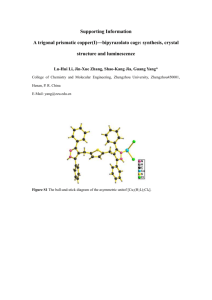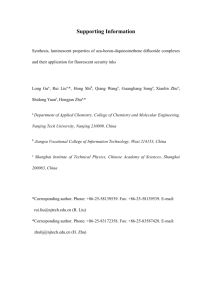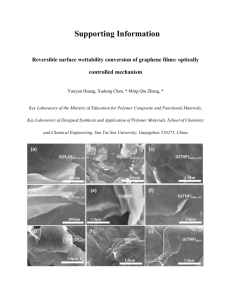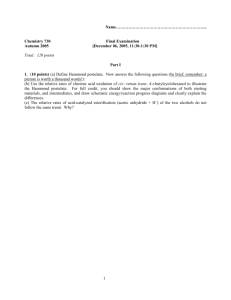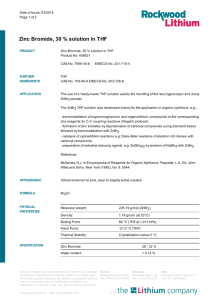Lucem Faciamus… The Design of New Probes for Fluorescence
advertisement
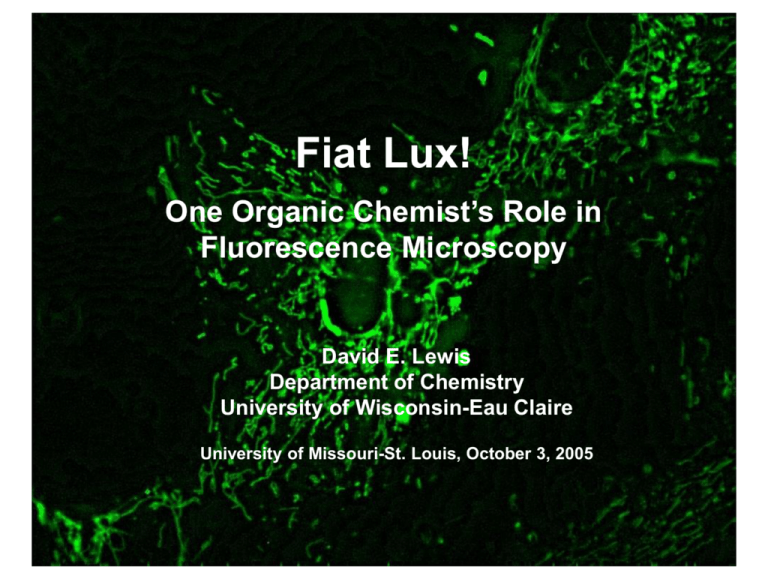
Fiat Lux! One Organic Chemist’s Role in Fluorescence Microscopy David E. Lewis Department of Chemistry University of Wisconsin-Eau Claire University of Missouri-St. Louis, October 3, 2005 Fluorescence • Singlet-singlet transitions – Singlet-triplet transition is phosphorescence – Lifetimes typically less than 1 s Difference between ex and em is known as Stokes shift – Large Stokes shift is desirable to minimize interference from E n e rg y • 1S 0S ex em • Scattering • Indigenous fluorescence r model of fluorescence in a diatomic molecule Preferred probe properties • • • • • • high selectivity for the target molecule or organelle. resistant enough to photochemical degradation under normal illumination conditions to permit the target cell feature to be visualized conveniently. preferably sufficiently non-toxic to allow live cells to be used for the experiment. highly fluorescent (i.e. it should have a high quantum yield for fluorescence), so that only small amounts of the dye are needed to visualize the cell target of interest. large Stokes shift to minimize problems from light scattering by the cell preferably easy to make from readily available, inexpensive starting materials, and chemically stable to permit long-term storage. The 4-amino-1,8-naphthalimide fluorophore – Photochemically robust – High quantum yields – Chemically easy to manipulate – Low toxicity – Easily delivered to live cells Localization/solubility HN R1 Fluorophore ex - 420 nm em - 520 nm O N R2 O Localization/solubility Fluorescence spectra of a representative 4-amino-1,8-naphthalimide • Large Stokes shifts (≥100 nm) 200 nM InstantLipo Sep- – Why? 25 20 R R NH NH FIU 15 10 O 5 0 325 375 425 475 525 575 625 N R O O N R GROUND STATE major minor EXCITED STATE minor major 675 Wavelength (nm) • Large quantum yield of fluorescence O The eucaryotic cell Mitochondria • Mitochondria are membrane-enclosed organelles distributed through the cytosol of most eukaryotic cells. Their main function is the conversion of the potential energy of food molecules into ATP. Mitochondria have: • an outer membrane that encloses the entire structure • an inner membrane that encloses a fluid-filled matrix • between the two is the intermembrane space • the inner membrane is elaborately folded with shelflike cristae projecting into the matrix. • a small number (some 5-10) circular molecules of DNA Key features of the mitochondrion to use in designing a mitochondrial stain • The inner mitochondrial membrane is characterized by – substantial amounts of phosphatidyl serine in the lipid mixture O O O O P O O O NH3 CO2 O – the presence of a net negative charge on the matrix side of the membrane. What structural features are needed in the dye? •Delocalized cationic dyes •Sufficient lipohilicity to be membrane-permeant Cl – Cyanines Cl • Mitotracker Green Cl N Me N O – Triphenylmethane (rhodamine) dyes Me2N N Cl Cl O NMe2 Me2N O NMe2 actively respiring cell • reduced dyes • Mitotracker Orange Cl Cl R R N R R N Me2N O O N R R R N NMe2 N NMe2 Me2N N N R O Me2N MitoTracker-type cyanines: four major resonance contributors with complete octets on all atoms; length of delocalized cation system is ≈6-7Å N O N R O Me2N N N R O R R N O O NMe2 NMe2 MitoTracker rhodamine-type dyes: four major resonance contributors with complete octets on all atoms; length of delocalized cation system is ≈9.5Å A potential new mitochondrial probe O H 2N NH O O 1) NaOMe/MeOH/DMF H 2N N (CH2) n Br 2) Br(CH2) nBr/DMF O n=4, 76%; n=6, 91% Me2N Kristy McNitt N/EtOH/ n=4, 56% n=6, 30% O H 2N N (CH2) n N O Br n = 6 InstantMito LMT-1 n = 4 InstantMito LMT-2 NMe 2 A potential new mitochondrial probe O H 2N NH O O 1) NaOMe/MeOH/DMF H 2N N (CH2) n Br 2) Br(CH2) nBr/DMF O n=4, 76%; n=6, 91% Me2N N/EtOH/ n=4, 56% n=6, 30% O H 2N N (CH2) n N O NMe 2 Br n = 6 InstantMito LMT-1 n = 4 InstantMito LMT-2 But… Is a 4-dimethylaminopyridinium ion delocalized enough? O O H2N H2N N (CH2)n N O NMe2 N (CH2)n N NMe2 O • Only 2 resonance contributors with complete octets • Length of conjugated, delocalized cation system is only 4.2Å • Most specialists active in fluorescence imaging of cells suggest that this is too short a conjugated system -- too localized -- to successfully cross the intervening membranes “Actually, yes!” THP-1 monocytes Lori Scardino human foreskin fibroblasts Confirming that we are localizing in mitochondria MitoTracker® Red: Commercially available mitochondrion dye Colocalization: InstantMito LMT-1 in THP-1 monocytes Yellow areas show where both dyes occupy the same place in the cell Acidic organelles: Golgi apparatus and lysosomes • Golgi is part of the protein transport system • trans Golgi is moderately acidic (pH ≈ 6.0) • Retrograde transport to Golgi by endocytosis is not uncommon QuickTime™ and a TIFF (LZW) decompressor are needed to see this picture. Lysosomes: the most acidic organelles • Lysosomes are roughly spherical bodies bounded by a single membrane. They are manufactured by the Golgi apparatus (pathway 2 in the figure). They contain over 3 dozen different kinds of hydrolytic enzymes including – – – – • proteases lipases nucleases polysaccharidases The pH within the lysosome is about pH 5, substantially less than that of the cytosol (~pH 7.2). All the enzymes in the lysosome work best at an acid pH. This reduces the risk of their digesting their own cell if they should escape from the lysosome. What structural features are needed in a lysosome probe? • Dyes that have been used for visualizing lysosomes are almost always - weak bases - membrane-permeant in their unprotonated form - tertiary aliphatic amines • Lysotracker Red N B N F F NH O NH NMe2 A new lysosomal stain NH2 Cl Cl HN C6H 13NH2 (1 eq) , 71% PhMe/, 89% O O O NH2 H2N O N O O N O Kristy McNitt InstantLyso LLT-1 Chang, S.-C.; Utecht, R.E.; Lewis, D.E. Dyes Pigments 1999, 43, 83-94. How well does it work? Not bad at all! QuickTi me™ and a TIFF (LZW) decompressor are needed to see this picture. InstantLyso LLT-1 A) Color epifluorescence image with live THP-1 monocytes at 75 nM and excited with blue light. B) Colocalization of InstantLyso LLT-1 and Lysotracker Red in live THP-1 cells; yellow represents colocalized probe. C) 3D reconstruction of a confocal image series using InstantLyso LLT-1 The accidental discovery: A stain for Golgi apparatus Recalling the Golgi apparatus • The Golgi apparatus consists of a stack of membrane-bounded cisternae located between the endoplasmic reticulum and the cell surface. A myriad of enzymes (proteins) are present in the Golgi apparatus to perform its various synthetic activities. So there must be mechanisms – to sort out the processed proteins and send them on to their destinations while – reclaiming processing proteins (e.g., glycosylases) for reuse. • pH varies from ≈6.7 in the cis Golgi to ≈6.0 in the trans Golgi What we were trying to do… Me O O S NH2 NH HN HN TsCl (2 eq.)/CH 2Cl2 16 h, 60% O N O O N O But… • The tosyl chloride was not recrystallized immediately prior to use • The same product was not obtained when freshly recrystallized tosyl chloride was used – We have completely characterized this product as the desired sulfonamide So… What happened? • Characterization: – The product showed p-toluenesulfonyl resonances in the 1H NMR spectrum – However, the product was not particularly soluble in nonpolar solvents – The product did appear to sequester in lysosomes in THP-1 monocytes NH2 NH3 HN SO3 HN • Answer: TsOH O N R O Me O N R O InstantLyso LLT-1 in fibroblasts BODIPY TR C5 ceramide complexed to BSA Colocalization: InstantLyso LLT-1 Live foreskin fibroblasts Yellow areas show where both dyes occupy the same place in the cell Targeting cholesterol • Plasma membranes are heterogeneous - • Membrane partitions into cholesterol-rich and cholesteroldeficient microdomains The visualization of cholesterol-rich microdomains of plasma membranes (“rafts”) is carried out in a number of ways. - dehydroergosterol H HO OH OH OH OH OH OH - the pentaene antibiotic, filipin OH HO H O Me Me - O use of labeled cholera toxin subunit B A new stain for cholesterolrich microdomains NH2 NH2 1) NaOMe/DMF InstantLipo Sep-1 2) Br(CH2) 7CH3 O N H O 80% O N O Kristy McNitt We have also prepared C6 to C18 analogues. These have not all been tested yet, but we know that a minimum of a C8 side chain is required. Chang, S.-C.; Utecht, R.E.; Lewis, D.E. Dyes Pigments 1999, 43, 83-94. It works in live THP-1 monocytes Confirming that we are localizing in high-cholesterol domains Vybrant® Alexa Fluor® 594: Current state of the art dye for high cholesterol domains Colocalization: Instant-Lipo Sep-1 Live THP-1 monocytes Yellow areas show where both dyes occupy the same place in the cell And it works in live foreskin fibroblasts… BODIPY TR C5 ceramide complexed to BSA Instant-Lipo Sep-1 Colocalization: Yellow areas show where both dyes occupy the same place in the cell Developing a putative model for the localization cholesterol InstantLipo Sep-1 The similarity of shape of these two molecules cholesterol InstantLipo Sep-1 Two views of the overlay of cholesterol and InstantLipo Sep-1 Gives us a 1:1 model for localization… cholesterol InstantLipo Sep-1 A 1:1 complex of cholesterol and InstantLipo Sep-1 … and another model with more cholesterols We are now attempting a cocrystallization of cholesterol and InstantLipo Sep-1 Other useful properties of some naphthalimide dyes Medium-dependent fluorescence emission… Fluorescence Ratio vs. Dielectric Constant Water and THF, Ex= 430 nm 3 25 FIU 20 15 10 5 0 450 500 550 Wavelength (nm) 600 650 100% THF 99.375% THF 98.75% THF 97.5% THF 95% THF 90% THF 85% THF 75% THF 65% THF 55% THF 45% THF 35 % THF 25% THF 15% THF 10% THF 5% THF 2.5%THF 1.25% THF .625% THF 0% THF 2.5 I(493)/I(550) 30 y = -0.2597x + 4.2257 2 1.5 1 y = -0.0108x + 1.2544 0.5 0 0 10 20 30 40 50 60 70 80 Dielectric Constant (D) The loss of the short-wavelength emission as the dielectric constant of the medium increases is demonstrated by InstantLipo Sep-1 in THF-water mixtures. Damon Campbell and Vinay Rao …which allows us to monitor local water content The dye probably orients itself perpendicular to the membrane surface, with the amino group of the 4naphthalimide oriented towards the aqueous external phase. The observed fluorescence of InstantLipo Sep-1 in THP-1 monocytes suggests that the local dielectric around the fluorophore is approximately 11.5 Another very medium-sensitive system: fluorescent Tröger’s bases O N OH O R N H2CO HCl/EtOH H2CO HCl/EtOH/ O O N R O R = n-Bu R = n-C8H18 N R N N O O 57% 66% O NH2 O N R N R = n-C6H13 N R O 74% Deprez, N.R.; McNitt, K.A.; Petersen, M.E.; Brown, R.G.; Lewis, D.E. Tetrahedron Lett. 2005, 46, 2149-2153. Solvent dependence of Tröger’s base fluorescence Solvent Dependence of Fluorescence of Compound 3a 140 cyclohexane (ex) cyclohexane (em) toluene (e) toluene (em) dichloromethane (ex) dichloromethane (em) ethyl acetate (ex) ethyl acetate )em_ acetonitrile (ex) acetonitrile (em) intensity (arbitrary units) 120 100 80 60 40 20 0 300 350 400 450 wavelength (nm) 500 550 But… It doesn’t cross the cell membrane Recall -- we want a bleachresistant stain for microscopy Photochemical bleaching studies Lysotracker Red -- the benchmark Lysotracker Red at 75 nM in THP-1 cells. Exposures were taken every 5 seconds (with consistent CCD exposure length) with green excitation cube. Unretouched, unprocessed images. Color is already faded extensively by 7 seconds and is nearly gone by 21 seconds. 7 seconds 21 seconds 35 seconds InstantLyso LLT-1 InstantLyso LLT-1 at 75 nM in THP-1 cells. Exposures were taken every 30 seconds (with consistent CCD exposure length 7.5 seconds) with blue excitation cube (490 nm maximum). Each exposure is some increment of 37.5 seconds. We have skipped the middle group of images. Unretouched, unprocessed images. 0 seconds 75 seconds 338 seconds Betsy Ott and Lori Scardino The comparison… 7 seconds 21 seconds 35 seconds Lysotracker Red 0 seconds 75 seconds 338 seconds InstantLyso LLT-1 InstantLipo Sep-1 InstantLipo Sep-1 at 200 nM in THP-1 cells. Exposures were taken with consistent CCD exposure length with purple excitation cube. Unretouched, unprocessed images. 5 seconds 35 seconds 65 seconds (For comparison purposes, filipin has faded completely within 15 seconds) So where to now? Dyes derivatized with carbohydrates or other interesting biomolecules Cl Cl Cl NH2 O O TsNH2/THF Br2/CH2Cl2 quantitative AcOH/ 85-90% O Cl O N O O N O Br O N Br NHTs NHR NHR Cl NaH/THF e.g. O O N N O O NHTs N Ts O Robyn Laskowski O N O NHTs O O HO OH HO OH HO OH galactose O Br OH O OH glucose Has already led to some unexpected chemistry Cl Cl NHBu NH2 BuNH2/ 70-83% AcOH/ 85-90% O O O O N O O NHBu Br2/CH2Cl2 N O Br Br O NHBu Br + O N NH2 Br + O N O Br Br O N O Br Br Acknowledgments • Lewis Research Group – – – – Kristy McNitt Grant Sormunen Robyn Laskowski Jessica Walters • Hartsel Research Group –Lori Scardino –Damon Campbell –Betsy Ott –Vinay Rao • Finances – UW-Eau Claire sabbatical – UW-Eau Claire Office of Research and Sponsored Programs – NSF-RSEC, University of Minnesota

